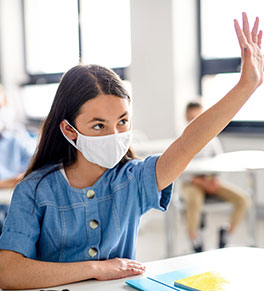Can kids go back to school safely?

With Orange County now off the state’s watch list for the novel coronavirus, there’s a very good chance that many kids will be back in classrooms soon. When that happens, UCI Health experts say basic safety precautions must be in place.
“If we stay off the watch list, a lot of parents will be asking why we aren’t opening schools in some form,” says UCI Health pediatric pulmonologist Dr. Dan Cooper, a national expert on children’s health and director of the UCI Institute for Clinical & Translational Science.
School shutdowns were intended to protect children and their families from exposure to the virus by keeping them out of school. It hasn’t worked, Cooper says. In fact, the number of pediatric COVID-19 cases has gone up rapidly across Southern California and the nation in recent months during school closures.
“That tells us it’s impossible right now to prevent kids from interacting with each other and with adults,” he says. “The virus is here, and people have to disabuse themselves of the idea that we can be 100% safe.
“We need to face it, mitigate it and make school — as much as possible — a healthy place.”
Preparing campuses
For elementary and secondary schools to reopen safely, students, teachers and staff members all must:
- Practice physical distancing
- Wear face masks
- Be diligent about hand hygiene
- Learn in disinfected classrooms and facilities
But a good deal more needs to happen, says Cooper, who has been advising the Orange County Department of Education and some school districts on how to resume to in-person learning. “This is not rocket science, it’s logistics,” he says.
Every school needs an individualized plan laying out the safety measures and actions that will be taken to lower the risk of spreading the virus. And each school plan should have procedures for:
- Daily checks of students and staff for COVID-19 symptoms and fevers
- Creating groups of 10 to 15 students to be taught by a single teacher
- Organizing classrooms to ensure physical distancing between students and teachers
- Providing masks for students, teachers or staff do not have them, and making sure each person knows how to wear one
- Responding appropriately when a teacher, staff member or student develops COVID-19 symptoms during the day, including determining a space on campus to isolate the person and procedures for contacting a relative
- How and when basic masking, physical distancing and hand hygiene precautions are to be taken, as well as how to handle people who won’t comply
- Providing personal protective equipment (PPE) for aides to students with special needs who may not be able to comply
Is it COVID-19?
Of course not every cough, runny nose or fever should strike fear in the hearts of school officials.
As parents know well, children, especially the younger ones, are veritable germ factories.
The trick is to help school nurses, principals and others determine whether a child’s symptoms indicate a cold virus or something that doesn’t require sending students and staff into quarantine.
To that end, Cooper and his UCI colleagues are developing a tool to help school officials make that determination.
Safety precautions work
“What the experiences of European and Asian schools has shown us is that if you adhere to these guidelines, you can minimize outbreaks,” Cooper explains. “When people distance and wear masks, virus transmission is very, very low.”
There will inevitably be cases of the virus, but following these guidelines will put schools a step ahead in reducing its the spread. For example, if someone does get infected, their small group of classmates can be quarantined without closing the entire school.
Cooper noted that a school in another state has assigned seating for lunch. This way, if an outbreak occurs, they can begin contact tracing immediately with the infected student’s lunch partners.
Getting buy-in from kids
Cooper knows it will be difficult to get school kids to adhere to distancing, handwashing, and face-mask wearing.
But he’d rather see the 1.2 million kids in school districts in Orange and Los Angeles counties receive their education through instruction and consistent messaging in their classrooms instead of on their own.
With the younger children, making the precautions fun to follow can help. With older kids, appealing to their altruism to protect not only themselves but also their parents and grandparents will inspire compliance, he believes.
All this can be done,” says Cooper.
At the same time, though, clinicians, virology experts and epidemiologists need to look for new and better methods to combat the virus and help keep people safe.
“In parallel, we’ve got to be doing research to understand what’s working and what’s not.”




